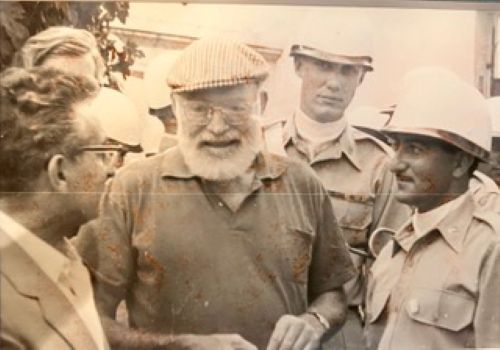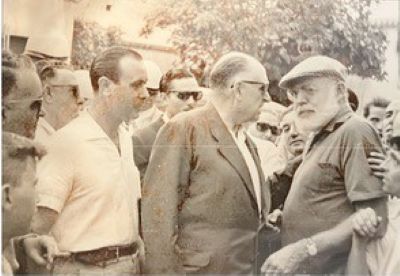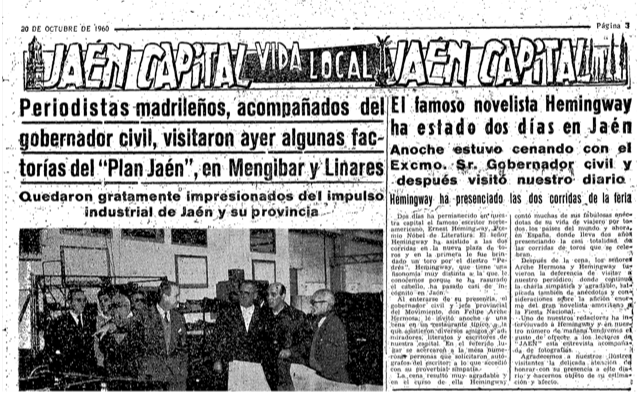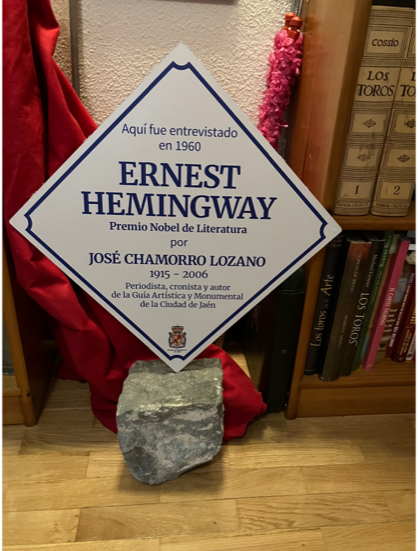
NOTE: Anyone reading this post should also read the accompanying correction, which asserts that it was Hemingway's double, Kenneth H. Vanderford, who visited Jaén.
We were having a final glass of wine after finishing dinner in a small restaurant on the main street in Jaén, Spain, when José said, "Here, have these two photos I took of Hemingway in the bullring before I interviewed him for the newspaper in the old offices by the cathedral, on the street Carrera de Jesús." Outside, the Holy Week procession of the carved, wooden figure of the sixteenth-century Cristo de los Estudiantes was slowly parading by.
"During the interview, Hemingway sat in one of the two identical chairs we had in the office for visitors. Before I retired, I gave them to my son. You've sat in them often at the house."

José Chamorro, father of my sister-in-law's husband, was a reporter on the staff of the local newspaper in Jaén, El Diario Jaén, in 1960. A few years later, he would become the director.
Hemingway was in Jaén for the annual Fería de San Lucas, which includes a fair and bullfights. The headlines of the 20 October edition of the newspaper state: "The famous novelist Hemingway has been in Jaén for two days. Last evening he dined with the civil governor and afterwards he visited our offices. Hemingway has attended the two corridas de toros during the fair."1

On 18 October during the unofficial inauguration of the bullring still under construction, the torero Pedro Martínez González, "Pedrés," dedicated a bull to Hemingway. The article informs readers that an interview with Hemingway would be published the following day: "One of our reporters has interviewed Hemingway and in tomorrow's edition we will have the pleasure of offering the readers of El Diario Jaén the interview, accompanied by photos." A search in the archives of El Diario Jaén, however, reveals that the interview was not published.
In 2024 following a proposal by the Municipal Board of Culture, Tourism, Fairs and Historical Patrimony aimed at promoting tourism, plaques commemorating the visits of noteworthy personages were made and placed on the pertinent walls of buildings throughout the town. But before the plaque acknowledging Hemingway's interview was placed on the wall of the building housing the former offices of El Diario Jaén, it was brought to the attention of the historical committee that the interview had not been published and, therefore, could not be authenticated, since José Chamorro had passed in 2006. Why the interview did not appear is unknown, although it is rumored that it was suppressed by the authorities because Hemingway, who had supported the Republic during the Spanish Civil War, held liberal views that were opposed to the Franco regime.

If evidence of the interview surfaces, the plaque will be returned to Jaén, to be placed on the wall of the former newspaper headquarters on Carrera de Jesús.
1 All translations from Spanish to English are by the author.
Larry Belcher is a retired professor from the Universidad de Valladolid in Vallladolid, Spain.